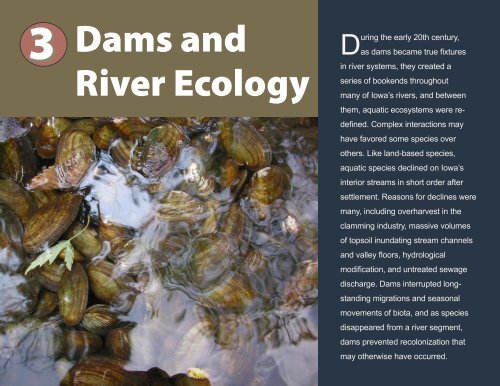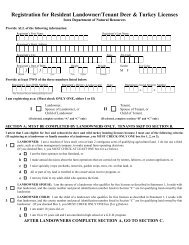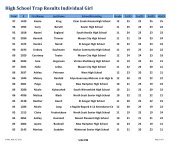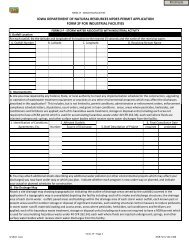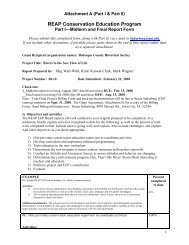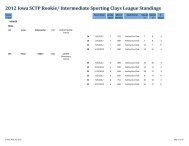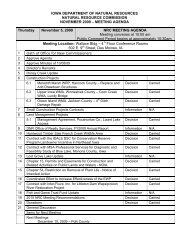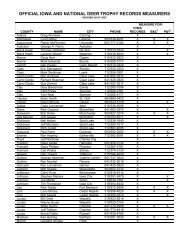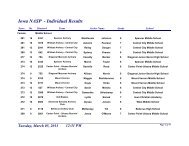3 Dams and River Ecology - Iowa Department of Natural Resources
3 Dams and River Ecology - Iowa Department of Natural Resources
3 Dams and River Ecology - Iowa Department of Natural Resources
Create successful ePaper yourself
Turn your PDF publications into a flip-book with our unique Google optimized e-Paper software.
3 <strong>Dams</strong> <strong>and</strong><br />
<strong>River</strong> <strong>Ecology</strong><br />
29<br />
During the early 20th century,<br />
as dams became true fixtures<br />
in river systems, they created a<br />
series <strong>of</strong> bookends throughout<br />
many <strong>of</strong> <strong>Iowa</strong>’s rivers, <strong>and</strong> between<br />
them, aquatic ecosystems were re-<br />
defined. Complex interactions may<br />
have favored some species over<br />
others. Like l<strong>and</strong>-based species,<br />
aquatic species declined on <strong>Iowa</strong>’s<br />
interior streams in short order after<br />
settlement. Reasons for declines were<br />
many, including overharvest in the<br />
clamming industry, massive volumes<br />
<strong>of</strong> topsoil inundating stream channels<br />
<strong>and</strong> valley floors, hydrological<br />
modification, <strong>and</strong> untreated sewage<br />
discharge. <strong>Dams</strong> interrupted long-<br />
st<strong>and</strong>ing migrations <strong>and</strong> seasonal<br />
movements <strong>of</strong> biota, <strong>and</strong> as species<br />
disappeared from a river segment,<br />
dams prevented recolonization that<br />
may otherwise have occurred.
During the Flood <strong>of</strong> 2008, many<br />
species moved up river over the<br />
7-foot-high Scott Street Dam<br />
<strong>and</strong> over the 10-foot high Center<br />
Street Dam in Des Moines. Thous<strong>and</strong>s<br />
continued partway up an<br />
emergency channel below the<br />
spillway at the Saylorville Dam<br />
where the spillway dam stopped<br />
further upstream progress. As<br />
waters receded <strong>and</strong> fish became<br />
locked in a pool, oxygen<br />
dwindled <strong>and</strong> most perished.<br />
Large catfish such as these were<br />
relocateed to the river. by DNR<br />
conservation <strong>of</strong>ficers.<br />
Fish passage restoration<br />
Some <strong>of</strong> the earliest dams constructed in <strong>Iowa</strong> created<br />
immediate controversy because the disconnecting effects<br />
on fish populations were not only dramatic, but had<br />
noticeable impacts on fishing. For example, when the Mc-<br />
Nutt’s Dam was constructed downstream <strong>of</strong> Decorah, the<br />
May 18, 1880 issue <strong>of</strong> the Decorah Republican reported:<br />
“Perhaps ‘millions’ is an exaggeration, but the numbers<br />
were so large that there was no skill whatever necessary<br />
to secure a wagon-load in a very short time. One<br />
party became so satiated with catching with a hook <strong>and</strong><br />
line that they threw back into the river anything smaller<br />
than two pounds. Big pickerel <strong>and</strong> three or four pound<br />
bass were plentiful.” Citizens the same year complained<br />
30<br />
that stocking allocations were not large enough. Black<br />
bass were seined from Mississippi <strong>River</strong> backwaters <strong>and</strong><br />
transported by rail to Decorah. Similarly during the late<br />
1800s, Des Moines poet <strong>and</strong> outdoorsman Tacitus Hussey<br />
went on an unsuccessful campaign to have a fish ladder<br />
installed at the Bonaparte Dam on the lower Des Moines<br />
<strong>River</strong> to improve fishing in Des Moines. Eventually, a flood<br />
took out the entire dam, solving the issue. In 1877, State<br />
Fish Commissioner B.F. Shaw wrote: “ The plan <strong>of</strong> building<br />
mill-dams now in vogue in <strong>Iowa</strong> makes the structures a<br />
barrier to the passage <strong>of</strong> fish to the sources <strong>of</strong> the rivers in<br />
spawning season.” Eventually, new dams were required to<br />
install fishways.<br />
While <strong>Iowa</strong> Code required fishways, the prevailing design<br />
worked primarily for salmon <strong>and</strong> trout. Midwestern native<br />
species used them sporadically at best. Underst<strong>and</strong>ing<br />
the physiology <strong>of</strong> native fish is important. Salmonids,<br />
such as salmon or trout, migrate long distances <strong>and</strong> up<br />
mountain streams. As a result, they evolved with an ability<br />
to leap up small waterfalls to access spawing waters.<br />
Midwestern species could access hundreds <strong>of</strong> thous<strong>and</strong>s<br />
<strong>of</strong> miles <strong>of</strong> streams without such leaping abilities.<br />
Recent research shows virtually all native Midwestern fish<br />
species exhibit movement for a variety <strong>of</strong> reasons, including<br />
accessing overwintering habitat, accessing feeding<br />
habitat, predator avoidance, avoiding adverse stream<br />
conditions <strong>and</strong> reproduction. Scores <strong>of</strong> rapids conversions<br />
<strong>and</strong> dam removals in Minnesota <strong>and</strong> Wisconsin<br />
have shown many species, including small, non-game<br />
fish, in downstream segments have quickly colonized<br />
upstream segments (Katopodis; 2006). The only known<br />
<strong>Iowa</strong>-native species that migrates as a life-cycle requirement<br />
is the American eel, which live its adult life in large,<br />
mud-bottomed rivers <strong>and</strong> moves via the big rivers to the<br />
Gulf <strong>of</strong> Mexico <strong>and</strong> into the Atlantic ocean east <strong>of</strong> the<br />
Bahamas to spawn. <strong>Dams</strong> likely restrict the eel’s range<br />
in <strong>Iowa</strong>, but it is not considered threatened (Mayhew).<br />
Native game fish species are known to bunch up at dams<br />
around spawning time, providing angling opportunities.<br />
Fish attempt to access various feeding zones during<br />
different growth stages. Spawning <strong>of</strong>ten occurs in <strong>Iowa</strong>’s
smallest streams to help their young avoid predators. Cool-water species such as northern<br />
pike, smallmouth bass, <strong>and</strong> trout move into tributary streams, stream headwaters,<br />
or near spring sources for thermal refuge during hot summer periods. Access to refuge<br />
areas is also important when an unintended chemical or manure spill occurs, or when<br />
periods <strong>of</strong> poor water quality conditions such as low oxygen, exist in a given segment.<br />
During high water, some small dams submerge <strong>and</strong> create temporary connectivity,<br />
while some <strong>of</strong> the tallest dams are always barriers. As dams submerge, large numbers <strong>of</strong><br />
fish can typically be observed attempting to move up rivers <strong>and</strong> streams.<br />
Today, 206 dams on <strong>Iowa</strong> streams with watershed sizes meeting the 2010 dam inventory<br />
criteria are classified as dams that block native fish passage. Some <strong>of</strong> these block fish<br />
passage at all times, or nearly always. Figure 3-b shows total observed species for river<br />
segments between dams, <strong>and</strong> this map forms the study area for biological connectivity.<br />
It should be noted that the inventory, review, <strong>and</strong> plan considers only dams on major<br />
streams, primarily down to 50 square mile watersheds. Smaller watersheds include<br />
thous<strong>and</strong>s <strong>of</strong> additional dams <strong>and</strong> culvert crossings that block fish passage, <strong>and</strong> lack <strong>of</strong><br />
access to headwater streams may be a serious constraint biological productivity. Others<br />
block fish passage for a significant time during a normal growth season. Minor dams<br />
that submerge very frequently were not considered fish passage obstructions.<br />
More extensive movements<br />
Extensive movement <strong>of</strong> <strong>Iowa</strong> fish documented in <strong>Iowa</strong> fish, including brook trout, channel<br />
catfish, flathead catfish, paddlefish, lake sturgeon, muskellunge, sauger, smallmouth<br />
bass, walleye, <strong>and</strong> white bass. The largest known paddlefish on record was a 198 pound<br />
fishspeared in Lake Okoboji in 1916; the paddlefish is now extirpated from the Okoboji<br />
lake system, . The lake sturgeon, also know as “rock sturgeon” through tagging studies<br />
is known to move more than 1,000 miles <strong>and</strong> Missouri <strong>Department</strong> <strong>of</strong> Conservation<br />
has stocked them in species recovery efforts <strong>and</strong> tagged lake sturgeon moved as far<br />
Lock <strong>and</strong> Dam 19 at Keokuk on the Mississippi <strong>River</strong>, <strong>and</strong> the Gavins Point Dam on the<br />
Missouri <strong>River</strong> in South Dakota (St. Pierre, 2004). <strong>Dams</strong> are considered a major limiting<br />
factor in the recovery <strong>of</strong> this endangered species. <strong>Iowa</strong>’s only remnant lake sturgeon<br />
populations exist <strong>Iowa</strong> border in the Mississippi <strong>River</strong>, with some likely use <strong>of</strong> lower<br />
segments <strong>of</strong> major tributaries (Mayhew, 1987). Walleye <strong>and</strong> channel catfish have been<br />
studied extensively on the Turkey, <strong>Iowa</strong>, <strong>and</strong> Mississippi rivers in <strong>Iowa</strong> using radio telemetry<br />
on tagged individuals. They exhibit frequent movements, with major movements<br />
toward deep water areas for over-wintering (Gelwicks, 2008).<br />
General benefits<br />
Improved connectivity for fish, in general, leads to broader benefits which may include<br />
more robust game fish populations, reduced risks for threatened <strong>and</strong> endangered species,<br />
<strong>and</strong> speedier fish growth (Wisconsin DNR, 2010). Impounded areas upstream <strong>of</strong><br />
Potential channel catfish recovery areas<br />
An important gamefish, the channel catfish, is not always found in stream sampling where it otherwise<br />
would be expected. In those reaches, they may be under population duress, or may have<br />
been extirpated. Channel catfish appear to be highly dependent on deepwater overwintering<br />
habitat. They are known to move long distances upriver during warm months when connectivity<br />
exists, <strong>and</strong> tend to move downstream to the nearest deep water (Gelwicks, 2008 Powerpoint<br />
presentation). This deep-water seeking habit in the past may have resulted in channel catfish<br />
moving downriver over dams, with no ability to return upstream <strong>of</strong> the dam. Areas with channel<br />
catfish downstream, but not upstream, <strong>of</strong> a dam were identified as segments where angling opportunities<br />
for this popular gamefish may be restored.<br />
Fig. 5-2 Segments with No Channel Catfish Observed At Monitoring Site<br />
Figure 3-a: Segments with No Channel Catfish Observed At Monitoring Site<br />
Big Sioux <strong>River</strong><br />
Legend<br />
XW<br />
XW<br />
Lyo-3<br />
31<br />
XWXW XW<br />
XW<br />
XWXWXWXWXW<br />
XW XW<br />
XW<br />
Woo-5<br />
Rock <strong>River</strong><br />
Woo-6<br />
Fish barrier<br />
Floyd <strong>River</strong><br />
Fish segments<br />
Major Lakes<br />
XW<br />
County Boundary<br />
Sio-4<br />
Woo-9<br />
Woo-11<br />
XW XW<br />
Mon-3<br />
Missouri <strong>River</strong><br />
Lyo-6<br />
Lyo-2<br />
Woo-13<br />
Mon-2<br />
West Fork Little Sioux <strong>River</strong><br />
Has-1<br />
XW<br />
XW XW<br />
Little Sioux <strong>River</strong><br />
Soldier <strong>River</strong><br />
Willow Creek<br />
XW<br />
XW<br />
Boyer <strong>River</strong><br />
Keg Creek<br />
Pot-4<br />
Obr-1<br />
Osc-1<br />
Has-3<br />
XW<br />
XWXW XW<br />
XW<br />
XW<br />
Channel Catfish observed at biosite<br />
XW<br />
XW<br />
XW<br />
Pot-8<br />
Mil-1<br />
XW<br />
XW<br />
Silver Creek<br />
Silver Creek<br />
Ocheyedan <strong>River</strong><br />
Mill Creek<br />
XW<br />
She-2<br />
Has-4<br />
Has-5<br />
Channel Catfish not observed at biosite<br />
Pot-6<br />
Pot-9<br />
She-6<br />
West Nishnabotna <strong>River</strong><br />
Mot-6<br />
XW<br />
XW<br />
Walnut Creek<br />
Cra-1<br />
XW<br />
Pot-2<br />
Mot-4<br />
XW<br />
XW<br />
XW XW XW<br />
XW<br />
XW<br />
XW<br />
Pag-6 Pag-4<br />
XW<br />
XW<br />
Pag-2<br />
XW<br />
XW<br />
XW<br />
Bue-1<br />
Cra-2<br />
XW<br />
XW<br />
XW<br />
XW<br />
East Nishnabotna <strong>River</strong><br />
Mot-2<br />
Pag-3<br />
Nodaway <strong>River</strong><br />
Nodaway <strong>River</strong><br />
XW<br />
Dic-3<br />
Dic-4<br />
Cas-4<br />
Pag-1<br />
XW<br />
XW<br />
XW<br />
Cas-2<br />
XW<br />
XW<br />
Emm-3<br />
XW<br />
Car-7<br />
Car-8<br />
Aud-2<br />
Tay-3<br />
West Fork Des Moines <strong>River</strong><br />
XW<br />
XWXW<br />
XWXW XW<br />
Gut-3<br />
Tay-4 Tay-1<br />
Tay-2<br />
Ada-1<br />
Gut-5<br />
XW<br />
XW<br />
Hum-1<br />
XW<br />
XW<br />
Hum-5<br />
Hum-2<br />
XW<br />
Web-4<br />
Web-8<br />
XWXWXW XW XW<br />
XW<br />
XW<br />
XW<br />
XW<br />
XW XW<br />
North <strong>River</strong><br />
XW<br />
XW<br />
XW<br />
North Raccoon <strong>River</strong><br />
Wri-1<br />
Boone <strong>River</strong><br />
Web-5<br />
Web-7<br />
Ham-7<br />
Ham-3<br />
Web-11<br />
Gut-1<br />
Dal-1<br />
Dal-3<br />
XWXW<br />
Boo-3<br />
Boo-2<br />
Dal-2<br />
Mad-2<br />
XW<br />
XW XW<br />
XW XW<br />
XW<br />
Winnebago <strong>River</strong><br />
Sto-7 Sto-6<br />
Pol-7<br />
Pol-5<br />
Pol-8<br />
XW XWXW<br />
Sto-5<br />
Pol-2<br />
Middle <strong>River</strong><br />
XW<br />
Wor-1<br />
XW<br />
XW<br />
XWXW<br />
XW<br />
XW XWXW<br />
XW XWXWXWXWXW XW<br />
XW<br />
XW<br />
XW<br />
XWXW<br />
XW<br />
XW<br />
South Skunk <strong>River</strong><br />
Wor-2<br />
<strong>Iowa</strong> <strong>River</strong><br />
XW<br />
Des Moines <strong>River</strong><br />
Mit-2<br />
Mit-1<br />
Mit-5<br />
XW<br />
XW<br />
XW<br />
XW<br />
XW<br />
Mit-3<br />
XW<br />
Mit-7<br />
Mri-1<br />
XW<br />
XW<br />
XW<br />
Mit-4<br />
Cedar <strong>River</strong><br />
Cer-19 Cer-5 Mit-8<br />
Flo-6<br />
Cer-9<br />
Fra-1 Fra-3<br />
Har-1 Har-2<br />
Fra-2<br />
Flo-3<br />
Cer-10<br />
Har-3<br />
Flo-4<br />
Flo-5<br />
But-5<br />
XW<br />
XW<br />
XW<br />
App-1<br />
XWXW<br />
But-1<br />
XW<br />
XW XW<br />
XW<br />
XW<br />
XW<br />
XW<br />
XW<br />
XW<br />
XWXW<br />
XW XW<br />
XW<br />
XW<br />
XWXW<br />
XW<br />
XW<br />
Crane Creek<br />
XW<br />
XW<br />
XW<br />
XW<br />
XW XWXW<br />
XW<br />
XW<br />
XWXW<br />
XW<br />
XW XW<br />
XW<br />
XW<br />
XW XW<br />
XW<br />
XWXW XW<br />
XW<br />
XW<br />
XWXW<br />
XW XW<br />
XW<br />
XW XW<br />
XW<br />
XW<br />
XW<br />
XW<br />
XW<br />
XW<br />
XW<br />
XW<br />
Beaver Creek Lytle Creek<br />
<strong>Iowa</strong> <strong>River</strong><br />
Jas-2<br />
Gru-3<br />
Jas-1<br />
Chariton <strong>River</strong><br />
Flo-2<br />
But-3<br />
But-4<br />
How-6<br />
Wap-1<br />
How-3<br />
How-2 How-1<br />
Chi-3<br />
Chi-2<br />
Chi-4<br />
Chi-1<br />
Bre-1<br />
Bla-1<br />
Bla-4<br />
Bla-2<br />
Bla-5<br />
Cedar <strong>River</strong><br />
How-4<br />
Buc-2<br />
Fay-9<br />
Fay-7<br />
Buc-3<br />
Win-3<br />
Iow-1<br />
Fay-2<br />
Fay-8<br />
Buc-4<br />
Win-2<br />
Win-1<br />
English <strong>River</strong><br />
Upper <strong>Iowa</strong> <strong>River</strong><br />
Volga <strong>River</strong><br />
Buc-5<br />
Skunk <strong>River</strong><br />
Big Cedar Creek<br />
Lin-5 Lin-7<br />
Lin-2<br />
Fay-4<br />
Del-2<br />
Del-3<br />
Lin-3<br />
Joh-1<br />
Hen-1<br />
Del-1<br />
Del-4<br />
Buffalo Creek<br />
Lin-6<br />
Joh-6<br />
Lin-4<br />
Joh-7<br />
Joh-2<br />
Des Moines <strong>River</strong><br />
Yellow <strong>River</strong><br />
Joh-3<br />
Cly-2<br />
Skunk <strong>River</strong><br />
Turkey <strong>River</strong><br />
Del-5<br />
Jon-1<br />
Cedar <strong>River</strong><br />
Lee-1<br />
All-1<br />
Cly-4<br />
Dub-2<br />
Jac-3<br />
Jon-3<br />
XW<br />
XW<br />
WXW<br />
XW<br />
XW<br />
XW<br />
Jon-2<br />
XW<br />
X<br />
Jac-1<br />
Jac-2<br />
XW<br />
XW<br />
Sco-1<br />
Mus-1<br />
Mus-3<br />
Lou-1<br />
Des-1<br />
Dub-3<br />
WX<br />
Maquoketa <strong>River</strong><br />
Wapsipinicon <strong>River</strong><br />
Sco-5<br />
Sco-2 Sco-4<br />
dams tend to favor generalist species such as common carp <strong>and</strong> green sunfish <strong>and</strong> replace more<br />
specialized species such as smallmouth bass, northern hog suckers, <strong>and</strong> various darters that are<br />
closely associated with coarse substrates <strong>and</strong> flowing water. Dam removal can restore flow <strong>and</strong> increase<br />
levels <strong>of</strong> dissolved oxygen in these areas. In cases were the substrate is rocky but overlaid by<br />
silt, species such as carp may be replaced by species such as smallmouth bass (Wisconsin DNR). As<br />
areas with greater species diversity are connected to segments with less diversity, both segments<br />
tend to benefit (Aadl<strong>and</strong>).<br />
XWXWXW WX<br />
XW<br />
WX<br />
Sco-3<br />
Jac-4<br />
WX<br />
Cli-1
Fig. 5-1 Fish Species Present in Samples for Segments Between <strong>Dams</strong><br />
Big Sioux <strong>River</strong><br />
XW<br />
Missouri <strong>River</strong><br />
Lyo-3<br />
Woo-5<br />
Legend<br />
XW<br />
Figure 3-b. Presence <strong>and</strong> absence <strong>of</strong> fish species analysis from combined datasets.<br />
XWXWXWXWXW<br />
XW XW<br />
Woo-6<br />
Floyd <strong>River</strong><br />
Fish barrier<br />
Rock <strong>River</strong><br />
XWXW XW<br />
XW<br />
XW<br />
Major Lakes<br />
Sio-4<br />
Lyo-6<br />
Lyo-2<br />
XW<br />
XW XW<br />
Otter Creek<br />
Woo-9<br />
Woo-11<br />
Woo-13<br />
Mon-2<br />
Mon-3<br />
County Boundary<br />
Total Fish Species<br />
No data<br />
1-9<br />
10-19<br />
20-29<br />
30-49<br />
50-74<br />
>75 species<br />
Has-1<br />
XW<br />
XW XW<br />
Little Sioux <strong>River</strong><br />
Soldier <strong>River</strong><br />
Willow Creek<br />
XW<br />
XW<br />
Keg Creek<br />
Pot-4<br />
Missouri <strong>River</strong><br />
Obr-1<br />
Has-3<br />
Osc-1<br />
XW<br />
XWXW XW<br />
Boyer <strong>River</strong><br />
XW<br />
XW<br />
XW<br />
XW<br />
Pot-8<br />
XW<br />
Mill Creek<br />
XW<br />
Silver Creek<br />
XW<br />
Ocheyedan <strong>River</strong><br />
XW<br />
She-2<br />
Has-4<br />
Has-5<br />
Pot-6<br />
Pot-9<br />
Mil-1<br />
She-6<br />
West Nishnabotna <strong>River</strong><br />
Mot-6<br />
XW<br />
XW<br />
Walnut Creek<br />
XW<br />
XW<br />
XW<br />
XW XW XW<br />
XW<br />
Pag-6<br />
Cra-1<br />
Pot-2<br />
Mot-4<br />
Pag-4<br />
XW<br />
XW<br />
XW<br />
XW<br />
Pag-2<br />
Bue-1<br />
XW<br />
XW<br />
XW<br />
Cra-2<br />
XW<br />
XW<br />
XW<br />
XW<br />
XW<br />
XW<br />
XW<br />
XW<br />
XW<br />
XW<br />
XW<br />
XW<br />
XWXW<br />
XWXW XW<br />
XW<br />
XW<br />
XW<br />
XW<br />
XW<br />
XWXWXW XW XW<br />
XW<br />
North <strong>River</strong><br />
XW<br />
XW<br />
XW<br />
XW XW<br />
XW<br />
XW<br />
XW<br />
East Nishnabotna <strong>River</strong> Boone <strong>River</strong><br />
Mot-2<br />
Nodaway <strong>River</strong><br />
Dic-3<br />
Dic-4<br />
Cas-4<br />
Pag-1<br />
Cas-2<br />
Emm-3<br />
Car-7<br />
Car-8<br />
Aud-2<br />
Tay-3<br />
Tay-4<br />
West Fork Des Moines <strong>River</strong><br />
Middle Raccoon <strong>River</strong><br />
Gut-3<br />
Tay-1<br />
Tay-2<br />
Ada-1<br />
Gut-5<br />
Hum-2<br />
Web-4<br />
Web-8<br />
Gut-1<br />
Hum-1<br />
Web-5<br />
East Fork Des Moines <strong>River</strong><br />
Hum-5<br />
Web-7<br />
Boo-3<br />
Boo-2<br />
North Raccoon <strong>River</strong><br />
Dal-2<br />
Dal-1<br />
Dal-3<br />
South Raccoon <strong>River</strong><br />
Mad-2<br />
Gr<strong>and</strong> <strong>River</strong><br />
Wri-1<br />
Web-11<br />
Des Moines <strong>River</strong><br />
XWXW<br />
Ham-7<br />
Ham-3<br />
XW<br />
XW XW<br />
XW XW<br />
XW<br />
XW XWXW<br />
Middle <strong>River</strong><br />
XW<br />
Winnebago <strong>River</strong><br />
Sto-7 Sto-6<br />
Pol-7<br />
Pol-5<br />
Pol-8<br />
Sto-5<br />
Pol-2<br />
Wor-1<br />
XW<br />
Shell Rock <strong>River</strong><br />
XW<br />
XW XW XW XWXW XWXWXWXWXW<br />
XW<br />
XW<br />
XW<br />
XW<br />
South Skunk <strong>River</strong><br />
Wor-2<br />
Cer-19 Cer-5<br />
Cer-18 Cer-9<br />
Fra-1<br />
Har-1 Har-2<br />
Cer-10<br />
Fra-3<br />
Fra-2<br />
XW<br />
32<br />
Cedar <strong>River</strong><br />
XW<br />
XW<br />
<strong>Iowa</strong> <strong>River</strong><br />
Har-3<br />
XW<br />
XW XW<br />
Mit-3<br />
XWXW<br />
XW<br />
Mit-7<br />
XW<br />
XW<br />
Mit-2<br />
Flo-3<br />
Mit-5<br />
XW<br />
XW<br />
<strong>Iowa</strong> <strong>River</strong><br />
XW<br />
XW<br />
XW<br />
West Fork Cedar <strong>River</strong><br />
Mri-1<br />
Mit-8<br />
Flo-4<br />
Mit-4<br />
Flo-6<br />
Flo-5<br />
But-5<br />
XW<br />
XW<br />
XW<br />
XWXW<br />
XW<br />
Beaver Creek<br />
App-1<br />
Mit-1<br />
But-1<br />
Jas-2<br />
Chariton <strong>River</strong><br />
Little Cedar <strong>River</strong><br />
Gru-3<br />
Jas-1<br />
Flo-2<br />
But-3<br />
XW XW<br />
XW<br />
But-4<br />
XW<br />
XW<br />
XW<br />
XW<br />
XW<br />
Cedar <strong>River</strong><br />
How-2<br />
Chi-3<br />
Chi-2<br />
XWXW<br />
XW<br />
XW XW<br />
XW<br />
XWXW<br />
Black Hawk Creek<br />
North Skunk <strong>River</strong><br />
How-6<br />
Chi-4<br />
Wap-1<br />
How-3<br />
XW<br />
XW<br />
Crane Creek<br />
Chi-1<br />
Bre-1<br />
Bla-1<br />
Bla-4<br />
Bla-2<br />
Bla-5<br />
How-1<br />
How-4<br />
Buc-1<br />
XW<br />
XW<br />
XW<br />
XW<br />
XW<br />
Des Moines <strong>River</strong><br />
Fay-9<br />
Upper <strong>Iowa</strong> <strong>River</strong><br />
XW<br />
XWXW<br />
Fay-7<br />
Buc-2<br />
Win-3<br />
XW<br />
Wapsipinicon <strong>River</strong><br />
XWXW<br />
XW<br />
XW XW<br />
Turkey <strong>River</strong><br />
Cedar <strong>River</strong><br />
Iow-1<br />
Fay-2<br />
Fay-8<br />
Buc-4<br />
Win-2<br />
Win-1<br />
XW<br />
Volga <strong>River</strong><br />
Buc-3<br />
Buc-5<br />
XW<br />
XW XW<br />
Skunk <strong>River</strong><br />
Fay-4<br />
XW<br />
XW<br />
XWXW XW<br />
XW<br />
XW<br />
XWXW<br />
XW XW<br />
XW<br />
Lin-5 Lin-7<br />
Lin-3<br />
XW XW<br />
Lin-2<br />
Joh-1<br />
English <strong>River</strong><br />
Yellow <strong>River</strong><br />
Cly-1<br />
Del-1<br />
Del-2<br />
Del-3<br />
Del-4<br />
Lin-6<br />
XW<br />
XW<br />
Buffalo Creek<br />
Joh-6<br />
Hen-1<br />
Lin-4<br />
Joh-7<br />
Joh-2<br />
XW<br />
XW<br />
XW XW<br />
Lee-1<br />
All-1 All-1<br />
XW<br />
XW<br />
Cedar <strong>River</strong><br />
Cly-4<br />
North Fork <strong>of</strong> the Maquoketa <strong>River</strong><br />
Joh-3<br />
Cly-2<br />
Del-5<br />
Jon-1<br />
Jon-3<br />
XW<br />
XW<br />
Dub-2<br />
XW<br />
XW<br />
XW<br />
Mus-3<br />
Lou-1<br />
Jon-2<br />
Des-1<br />
XW<br />
Jac-3<br />
XW<br />
XW<br />
Lytle Creek<br />
XW<br />
XW<br />
Dub-3<br />
Jac-1<br />
Jac-2<br />
XW<br />
Maquoketa <strong>River</strong><br />
Wapsipinicon <strong>River</strong><br />
Sco-1<br />
Mus-1<br />
Sco-2 Sco-4<br />
XW<br />
XW XWXW<br />
XW<br />
XW<br />
Sco-6<br />
Jac-4<br />
Sco-5<br />
XW<br />
Cli-1
Mussel restoration efforts<br />
Native mussels are intimately connected with fish <strong>and</strong> fish migrations. Known to many <strong>Iowa</strong>ns as clams – they may be<br />
<strong>of</strong> increasing popular interest to <strong>Iowa</strong>ns as they learn more about their habits <strong>and</strong> life cycle. Mussels reproduce <strong>and</strong><br />
spread their young, called glochidia, via fish hosts through an astonishing variety <strong>of</strong> means. Some, such as the pocketbook<br />
mussel, have modified mantle tissue that serves as a fish “lure,” which attracts fish near. It then sprays glochidia,<br />
some <strong>of</strong> which attach to the fish gills <strong>and</strong> move to new waters where the fish will spawn. Others wait with shells open<br />
in ambush. When a small fish like the logperch that forages by dislodging pebbles gets too near, the mussel clamps<br />
down <strong>and</strong> holds the small fish, injecting it with glochidia. (Barnhart, 2008)<br />
<strong>Iowa</strong>’s mussels filter feed on tiny organisms such as phytoplankton <strong>and</strong> bacteria. (Heidebrink, 2002). A typical mussel<br />
can filter several gallons <strong>of</strong> water a day, <strong>and</strong> some can filter up to 10 gallons per day. If they are not overwhelmed with<br />
sediments, healthy mussel beds can clarify water <strong>and</strong> filter bacteria (Machtinger, 2007).<br />
About 12 species <strong>of</strong> mussel supported a post-settlement button industry beginning in 1891. By 1910 there were 70<br />
factories centered in Muscatine, employing 3,376 <strong>Iowa</strong>ns for a total product value <strong>of</strong> $4 million in 1910, equating to<br />
about $90 million today. However, the economic boon for eastern <strong>Iowa</strong>ns rapidly decimated mussel populations. As<br />
early as 1898, mussels had to be imported from Missouri <strong>and</strong> Illinois because <strong>of</strong> “overfishing, made worse by pollution,<br />
depleting the supply <strong>of</strong> oxygen in the rivers” (Annals).<br />
In recent years, the story <strong>of</strong> mussels has been one <strong>of</strong> declining populations <strong>and</strong> potential extirpation <strong>of</strong> a number <strong>of</strong><br />
species from <strong>Iowa</strong>. Unfortunately, they fall victim to a variety <strong>of</strong> today’s stresses on streams. Stressors may include excessive<br />
<strong>and</strong> overly frequent channel scour events that re-locate the animals to inopportune places or bury them under<br />
sediments, exessive nutrients or low dissolved oxygen, <strong>and</strong> an inability to re-polulate after events such as chemical<br />
spills. Mussels <strong>of</strong> greatest conservation need are identified in the <strong>Iowa</strong> Wildlife Comprehensive Plan.<br />
GIS modeling was used to compare fish host <strong>and</strong> mussel presence datasets to indicate study areas for recovery (Figure<br />
3-c) <strong>and</strong> potential re-colonization <strong>of</strong> mussels identified as species <strong>of</strong> greatest conservation need (SGCN). An attempt<br />
was made to examine segments upstream <strong>of</strong> dams where both mussels <strong>and</strong> known fish hosts (Kurth, 2009) had not<br />
been sampled, but had been sampled in a segment downstream <strong>of</strong> the dam. Data was insufficient to find examples.<br />
In lieu <strong>of</strong> this, for calculating scores for biological priority (see Appendix C), proximity <strong>of</strong> SGCN mussels sampled near<br />
dams was used for prioritization. Sample sites for mussels are not as extensive or geographically balanced as they are<br />
for fish, but the map does outline areas worthy <strong>of</strong> consideration. If a dam is being considered for a fish passage project,<br />
additional mussel sampling should be conducted within the project scope. In the future, study is needed to verify that<br />
fish hosts <strong>and</strong> their glochidia take advantage <strong>of</strong> access to upstream reaches. In addition, the immediate project area<br />
should be surveyed for mussels by a qualified pr<strong>of</strong>essional to ensure that various species under population decline are<br />
not disturbed in the project area.<br />
Aquatic threatened <strong>and</strong> endangered species <strong>and</strong> river connectivity<br />
In addition to mussels, a number <strong>of</strong> fish species are also imperiled, <strong>and</strong> have been determined by state <strong>and</strong> federal<br />
authorities to warrant listing as a threatened <strong>and</strong> endangered species. <strong>Iowa</strong> administrative code (571—Chapter 77.2)<br />
defines animal species to be endangered, threatened or <strong>of</strong> special concern.<br />
State threatened <strong>and</strong> endangered species include:<br />
33<br />
Common Name Scientific Name<br />
<strong>Iowa</strong><br />
Abun.<br />
<strong>Iowa</strong><br />
Trend<br />
Elktoe Alasmidonta marginata U D<br />
Slippershell Alasmidonta viridis R D<br />
Flat floater Anodonta suborbiculata R D<br />
Cylinder Anodontoides ferussacianus R D<br />
Rock pocketbook Arcidens confragosus U D<br />
Spectacle case Cumberl<strong>and</strong>ia monodonta R D<br />
Purple pimpleback Cyclonaias tuberculata R/X D<br />
Butterfly Ellipsaria lineolata U K<br />
Spike Elliptio dilatata U D<br />
Ebonyshell Fusconaia ebena R D<br />
Ozark pigtoe Fusconaia ozarkensis X X<br />
Higgins’ eye pearlymussel Lampsilis higginsi R D<br />
Yellow s<strong>and</strong>shell Lampsilis teres anodontoides R D<br />
Slough s<strong>and</strong>shell Lampsilis teres teres R D<br />
Creek heelsplitter Lasmigona compressa R D<br />
Fluted shell Lasmigona costata R D<br />
Pondmussel Ligumia subrostrata X NA<br />
Hickorynut Obovaria olivaria U D<br />
Bullhead (Sheepnose) Plethobasus cyphus R D<br />
Round pigtoe Pleurobema sintoxia R D<br />
Monkeyface Quadrula metanerva U D<br />
Wartyback Quadrula nodulata U D<br />
Strange floater (Squawfoot) Strophitus undulatus R D<br />
Lilliput Toxolasma parvus R D<br />
Pistolgrip Tritogonia verrucosa R D<br />
Fawnsfoot Truncilla donaciformis R D<br />
Pondhorn Uniomerus tetralasmus R K<br />
Paper pondshell Utterbackia imbecillis R D<br />
Ellipse Venustaconcha ellipsiformis R D<br />
<strong>Iowa</strong> Abundance: A = abundant, C = common, U = uncommon, R = rare, K = unknown, X = possibly extirpated.<br />
<strong>Iowa</strong> Trend: K = unknown, I = increasing, S = stable, D = decreasing.<br />
Table 3-a: Mussel Species <strong>of</strong> Greatest Conservation Need,<br />
status <strong>and</strong> trend.
Legend<br />
X<br />
Potential Mussel Priority <strong>Dams</strong><br />
Fig. 5-3: Segments with Potential for Mussel Recolonization,<br />
Species <strong>of</strong> Greatest Conservation Need<br />
Figure 3-c. <strong>Dams</strong> on river segments with potential for species <strong>of</strong><br />
greatest conservation need <strong>and</strong> mussel recolonization.<br />
X<br />
Emm-3<br />
X<br />
X<br />
X<br />
X<br />
X<br />
Web-4<br />
Web-5<br />
Web-6<br />
Web-2<br />
Web-1<br />
X<br />
X<br />
Kos-11<br />
Hum-1<br />
Hum-2<br />
Hum-5<br />
X<br />
Wri-1<br />
X<br />
Ham-3<br />
Wor-3<br />
Wor-2<br />
Mit-2<br />
Mit-5<br />
Mit-3<br />
Mit-4<br />
Mit-1<br />
How-3<br />
Wor-1<br />
Mit-7Mit-8<br />
Flo-6<br />
How-2<br />
Cer-8Cer-9<br />
Cer-7<br />
Cer-6<br />
Mit-10<br />
Flo-3<br />
Flo-1<br />
Flo-4 Flo-2<br />
Chi-4<br />
Chi-3<br />
Cer-10<br />
Flo-5<br />
But-1<br />
Chi-2<br />
Chi-1<br />
Bre-1<br />
X<br />
X<br />
X<br />
X<br />
X X X X XX<br />
Fra-3<br />
Fra-2<br />
Fra-1<br />
X X<br />
Har-1 Har-2<br />
X<br />
X<br />
34<br />
X<br />
X<br />
X<br />
X X<br />
X<br />
X<br />
X<br />
X X<br />
X<br />
X<br />
X<br />
X<br />
X X<br />
X<br />
X<br />
X<br />
X<br />
X<br />
X<br />
X<br />
X<br />
Har-3<br />
But-7<br />
But-4<br />
But-5<br />
X<br />
Gru-3<br />
But-3<br />
X<br />
X<br />
X<br />
Bre-2<br />
X<br />
Bla-1 Bla-2<br />
Bla-4Bla-7<br />
Bla-3<br />
Bla-5<br />
Bre-5<br />
Buc-1Fay-7Fay-8<br />
Buc-6<br />
X<br />
X<br />
X<br />
X<br />
X<br />
Buc-2<br />
Buc-3Buc-4<br />
X<br />
Iow-1<br />
X<br />
Buc-5<br />
X<br />
Lin-5<br />
X X<br />
Del-3<br />
Del-2 Del-4<br />
Del-5<br />
XX X<br />
X<br />
X<br />
X X<br />
Lin-7<br />
Lin-6<br />
Lin-3<br />
Lin-2<br />
Lin-4<br />
X<br />
X Joh-7<br />
X<br />
Joh-3<br />
Joh-2<br />
Joh-1<br />
X<br />
Jon-3
<strong>Iowa</strong> endangered fish<br />
Lake Sturgeon (Acipenser fulvescens), Pallid Sturgeon (Scaphirhynchus<br />
albus), Pugnose Shiner (Notropis anogenus), Weed<br />
Shiner (Notropis texanu), Pearl Dace (Semotilus margarita),<br />
Freckled Madtom (Noturus nocturnus), Bluntnose Darter (Etheostoma<br />
chlorosomum), Least Darter (Etheostoma microperca)<br />
<strong>Iowa</strong> endangered fresh water mussels<br />
Spectacle Case (Cumberl<strong>and</strong>ia monodonta), Slippershell (Alasmidonta<br />
viridis), Buckhorn (Tritogonia verrucosa)<br />
Ozark Pigtoe (Fusconaia ozarkensis), Bullhead (Plethobasus<br />
cyphyus), Ohio <strong>River</strong> Pigtoe (Pleurobema sintoxia), Slough<br />
S<strong>and</strong>shell,(Lampsilis teres teres), Yellow S<strong>and</strong>shell (Lampsilis<br />
teres anodontoides), Higgin’s-eye Pearly Mussel (Lampsilis<br />
higginsi).<br />
<strong>Iowa</strong> threatened fish:<br />
Chestnut Lamprey (Ichthyomyzon castaneus), American Brook<br />
Lamprey (Lampetra appendix), Redfin (formerly “Grass”) Pickerel<br />
(Esox americanus), Blacknose Shiner (Notropis heterolepis),<br />
Topeka Shiner (Notropis topeka), Western S<strong>and</strong> Darter (Ammocrypta<br />
clara), Black Redhorse (Moxostoma duquesnei), Burbot<br />
(Lota lota), Orangethroat Darter (Etheostoma spectabile).<br />
<strong>Iowa</strong> Threatened Fresh water mussels:<br />
Cylinder (Anodontoides ferussacianus), Strange Floater (Strophitus<br />
undulatus), Creek Heelsplitter (Lasmigona compressa),<br />
Purple Pimpleback (Cyclonaias tuberculata), Butterfly<br />
(Ellipsaria lineolata), Ellipse (Venustaconcha ellipsiformis).<br />
<strong>Iowa</strong> fish <strong>of</strong> special concern:<br />
Pugnose Minnow (Notropis emiliae), Pirate Perch (Aphredoderus<br />
sayanus),<br />
In addition, there are three federally endangered aquatic species<br />
in <strong>Iowa</strong>: pallid sturgeon, Topeka shiner, Higgin’s eye mussel.<br />
As these species are priorities for federal recovery efforts,<br />
US Fish <strong>and</strong> Wildlife Service is likely to collaborate in species<br />
recovery involving fish passage targeted to benefit these<br />
species. Two additional mussels, the sheepnose (Plethobasus<br />
cyphyus) <strong>and</strong> the spectacle case (Cumberl<strong>and</strong>ia monodonta),<br />
are c<strong>and</strong>idates for federal listing.<br />
Special care should be used in dam-related projects not to<br />
damage habitat for these listed species as projects are constructed.<br />
But overall, improved river connections, longer segments<br />
between obstructions, <strong>and</strong> more diverse habitat than in<br />
existing river impoundments are likely to result in benefits for<br />
these species.<br />
Aquatic life impairments<br />
A number <strong>of</strong> reaches <strong>of</strong> river in <strong>Iowa</strong> have been monitored<br />
to detmermine whether they support heathly populations<br />
35<br />
<strong>of</strong> aquatic species. These may include specific listed species,<br />
they may document a decline in existing species, or they may<br />
indicate a segment is less diverse than would be expected <strong>of</strong> a<br />
more natural reference reach. If they do not attain the aquatic<br />
life uses they are designated to support, they are added to<br />
<strong>Iowa</strong>’s Section 303(d) listing <strong>of</strong> impaired streams for waters.<br />
The U.S. Environmental Protection Agency requires such lists<br />
from all states to comply with Section 303(d) <strong>of</strong> the federal<br />
Clean Water Act.<br />
<strong>Iowa</strong> DNR can remove segments from this listing when credible<br />
data can show designated uses are being attained. In<br />
some cases, carefully targeted dam mitigations may be able to<br />
help achieve this over-arching goal <strong>of</strong> removing listings. Using<br />
GIS coverages, impaired segments were visually compared<br />
to areas where a series <strong>of</strong> dams exists along rivers. A number<br />
<strong>of</strong> segments were identified where (Figure 3-d) dam mitigationpriorities<br />
may overlap with de-listing <strong>of</strong> a section. Where<br />
priorities overlap, there is a potential for collaboration with the<br />
<strong>Iowa</strong> DNR’s federally funded Section 319 watershed improvement<br />
program.<br />
Invasive species priorities<br />
While many factors discussed above favor connectivity, dam<br />
mitigation projects should not be assumed to automatically<br />
be <strong>of</strong> general benefit to river ecosystems. Invasive animals in<br />
<strong>Iowa</strong>’s streams present a clear <strong>and</strong> present danger that can<br />
quickly displace native species.<br />
Asian carp – preventive dams<br />
A consensus item among U.S. Fish <strong>and</strong> Wildlife Service staff,<br />
<strong>Iowa</strong> DNR fish management biologists, <strong>and</strong> IDNR Aquatic<br />
Invasive Species (AIS) staff is that certain dams should receive<br />
a great deal <strong>of</strong> scrutiny, research, <strong>and</strong> planning before a fishpassable<br />
connection is re-established to the Mississippi <strong>River</strong>,<br />
the Missouri <strong>River</strong>, or an Asian-carp- infested interior stream.<br />
Generally, these are the tallest dams (generally 10 feet or<br />
greater with infrequent submergence) that are farthest downstream<br />
on a river. Asian carp, including big head (Hypophthalmichthys<br />
nobilis) <strong>and</strong> silver carp (Hypophthalmichthys molitrix)<br />
are known to inhabit the Mississippi <strong>River</strong>, Missouri <strong>River</strong>, <strong>and</strong>
Legend<br />
XW<br />
XW<br />
Figure 3-d. <strong>Iowa</strong>’s section 2009 303(d) listed segments<br />
impaired for aquatic life, compared with dams that block<br />
biological connectivity.<br />
Big Sioux <strong>River</strong><br />
Fish barrier<br />
XW<br />
Lyo-3<br />
Woo-5<br />
Woo-6<br />
XWXWXWXWXW<br />
Rock <strong>River</strong><br />
Floyd <strong>River</strong><br />
XWXW XW<br />
XW<br />
XW XW<br />
XW<br />
XW<br />
Sio-4<br />
Woo-9<br />
Woo-11<br />
XW XW<br />
Mon-3<br />
Missouri <strong>River</strong><br />
Lyo-6<br />
Lyo-2<br />
Woo-13<br />
Woo-12<br />
Mon-2<br />
West Fork Little Sioux <strong>River</strong><br />
Has-1<br />
XW<br />
Impaired_Streams_With_<strong>Dams</strong><br />
Mississippi Lock & <strong>Dams</strong><br />
Fish segments<br />
TtlSpecies<br />
50 <strong>and</strong> > species<br />
30-49 species<br />
20-29 species<br />
10-19 species 10-19 species<br />
0-9 species 0 to 9 species<br />
0<br />
Major Lakes<br />
County Boundary<br />
XW<br />
XW XW<br />
Little Sioux <strong>River</strong><br />
Soldier <strong>River</strong><br />
Willow Creek<br />
XW<br />
Boyer <strong>River</strong><br />
Keg Creek<br />
Pot-4<br />
Obr-1<br />
Osc-1<br />
Has-3<br />
XW<br />
XWXW XW<br />
XW<br />
XW<br />
XW<br />
XW<br />
XW<br />
Pot-8<br />
Mil-1<br />
XW<br />
XW<br />
Silver Creek<br />
Silver Creek<br />
Ocheyedan <strong>River</strong><br />
Mill Creek<br />
XW<br />
She-2<br />
Has-4<br />
Has-5<br />
Pot-6<br />
Pot-9<br />
She-6<br />
West Nishnabotna <strong>River</strong><br />
Mot-6<br />
Walnut Creek<br />
XW<br />
XW<br />
XW<br />
XW<br />
XW<br />
XW<br />
XW<br />
XW<br />
XW<br />
XW<br />
XW<br />
East Nishnabotna <strong>River</strong><br />
Cra-1<br />
Pot-2<br />
Mot-4<br />
Pag-6 Pag-4<br />
Fig. 5-4 <strong>Iowa</strong>'s Section 303(d) Listing:<br />
Segments with <strong>Dams</strong> Impaired for Aquatic Life<br />
XW<br />
XW<br />
Pag-2<br />
XW<br />
XW<br />
XW<br />
Bue-1<br />
Cra-2<br />
Pot-1<br />
XW<br />
XW<br />
XW<br />
XW<br />
XW<br />
XW<br />
XW<br />
Nodaway <strong>River</strong><br />
Mot-2<br />
Pag-3<br />
XW<br />
Dic-3<br />
Dic-4<br />
North Raccoon <strong>River</strong><br />
Cas-1<br />
Cas-2<br />
Cas-4<br />
Pag-1<br />
XW<br />
XW<br />
Emm-3<br />
XW<br />
Car-7<br />
Car-8<br />
Aud-2<br />
Tay-3<br />
Tay-4<br />
West Fork Des Moines <strong>River</strong><br />
XW<br />
XWXW<br />
XWXW XW<br />
Gut-3<br />
Tay-2<br />
Ada-1<br />
Tay-1<br />
Gut-5<br />
XW<br />
XW<br />
XW<br />
XW<br />
Hum-2<br />
Hum-1<br />
XW<br />
XWXWXW XW XW<br />
XW<br />
Hum-5<br />
North <strong>River</strong><br />
XW<br />
XW<br />
XW<br />
XW XW<br />
XW<br />
XW<br />
XW<br />
Wri-1<br />
Boone <strong>River</strong><br />
XWXW<br />
XW<br />
XW XW<br />
XW XW<br />
XW<br />
Winnebago <strong>River</strong><br />
Pol-8<br />
XW XWXW<br />
Middle <strong>River</strong><br />
XW<br />
Wor-1<br />
XW<br />
South Skunk <strong>River</strong><br />
Des Moines <strong>River</strong><br />
Wor-2<br />
XW<br />
XW XW XW XWXW XWXWXWXWXW<br />
XW<br />
XW<br />
XW<br />
XW<br />
Shell Rock <strong>River</strong><br />
<strong>Iowa</strong> <strong>River</strong><br />
XW<br />
XW XWXW<br />
XW XW<br />
XW<br />
36<br />
XW<br />
XW<br />
XW XW<br />
North Skunk <strong>River</strong><br />
XW<br />
Mri-1<br />
XW<br />
XW<br />
XW<br />
XW<br />
XW<br />
XW<br />
XW<br />
App-1<br />
XWXW<br />
XW<br />
XW XW<br />
XW<br />
XW<br />
XW<br />
Beaver Creek<br />
Chariton <strong>River</strong><br />
XW<br />
XW<br />
XW<br />
XWXW<br />
XW<br />
XW XW<br />
XW<br />
Crane Creek<br />
XWXW<br />
XW<br />
XW<br />
XW<br />
XW<br />
XW<br />
XW<br />
Fay-9<br />
XW<br />
XW<br />
XWXW<br />
Win-3<br />
XW<br />
XWXW<br />
Win-2<br />
Win-1<br />
XW<br />
XW XW<br />
XW<br />
XW<br />
Upper <strong>Iowa</strong> <strong>River</strong><br />
Volga <strong>River</strong><br />
But-5<br />
Fay-7<br />
Del-1<br />
Web-4<br />
Web-8<br />
Web-5<br />
Web-7<br />
1<br />
Ham-7<br />
Ham-3<br />
Web-11<br />
Har-1 Har-2<br />
Har-3<br />
Gru-3<br />
Bla-1<br />
Bla-2<br />
Bla-5<br />
Bla-4<br />
Buc-2 Buc-4<br />
Buc-3 Buc-5 5<br />
Gut-1<br />
Boo-3<br />
Dal-2<br />
Dal-3<br />
Dal-1<br />
Mad-2<br />
Boo-2<br />
Sto-7 Sto-6<br />
Pol-7<br />
Pol-5<br />
Sto-5<br />
Pol-2<br />
Cer-9<br />
Fra-1<br />
Fra-3<br />
Fra-2<br />
3<br />
Cer-19 Cer-5<br />
Flo-3<br />
Cer-10<br />
Mit-3<br />
Mit-7<br />
Mit-2<br />
Mit-5<br />
Mit-4<br />
Mit-8<br />
Flo-4<br />
Jas-1<br />
Flo-6<br />
Flo-5<br />
Jas-2<br />
Mit-1<br />
But-1<br />
Flo-2<br />
But-3<br />
2<br />
But-4<br />
How-6<br />
Wap-1<br />
How-3<br />
How-2 How-1<br />
Chi-3<br />
Chi-2<br />
Chi-4<br />
Chi-1<br />
Bre-1<br />
How-4<br />
Fay-8<br />
Iow-1<br />
9<br />
Fay-2<br />
XW XW<br />
English <strong>River</strong><br />
XW<br />
XW<br />
XW<br />
XWXW<br />
XW XW<br />
XW<br />
Lin-5 Lin-7<br />
Lin-2<br />
4<br />
Fay-4<br />
Lin-3<br />
Buffalo Creek<br />
XW XW<br />
Lin-6<br />
XW<br />
Joh-6<br />
XWXW XW<br />
XW<br />
Joh-1<br />
Hen-1<br />
Lin-4<br />
Joh-7<br />
Joh-2<br />
Des Moines <strong>River</strong><br />
<strong>Iowa</strong> <strong>River</strong><br />
XW<br />
XW<br />
XW<br />
XW XW<br />
Yellow <strong>River</strong><br />
Del-5<br />
Joh-3<br />
Cly-2<br />
Skunk <strong>River</strong><br />
Turkey <strong>River</strong><br />
XW<br />
Bear Creek<br />
Del-2<br />
Del-3<br />
Del-4<br />
Jon-1<br />
Maquoketa <strong>River</strong><br />
XW<br />
Cedar <strong>River</strong><br />
Lee-1<br />
All-1 All-1<br />
Jon-3<br />
Cly-4<br />
N. Fork Maquoketa R.<br />
XW<br />
XW<br />
XW<br />
7<br />
6<br />
Dub-2<br />
XW<br />
XW<br />
Lou-1<br />
Jon-2<br />
Des-1<br />
XW<br />
Jac-3<br />
XW<br />
8<br />
XW<br />
XW<br />
XW<br />
Sco-1<br />
Mus-1<br />
Mus-3<br />
Dub-3<br />
Jac-1<br />
Jac-2<br />
XW<br />
Wapsipinicon <strong>River</strong><br />
Sco-2 Sco-4<br />
XW<br />
XW XWXW<br />
XW<br />
XW<br />
Sco-6<br />
Jac-4<br />
Sco-5<br />
XW<br />
Cli-1<br />
# <strong>River</strong> ABD Codes<br />
1 Lizard Creek IA 04-UDM-0300_1<br />
2 North Skunk R. IA 03-NSK-0020_2<br />
3 Cedar <strong>River</strong> IA 02-CED-0110_3<br />
4 <strong>Iowa</strong> <strong>River</strong> IA 02-IOW-0020_1<br />
5 Buffalo Creek IA 01-WPS-0130_1<br />
IA 01-WPS-0130_2<br />
6 Wapsipinicon IA 01-WPS-0010_4<br />
<strong>River</strong><br />
IA 01-WPS-0010_5<br />
7 Maquoketa IA 01-MAQ-0060_2<br />
<strong>River</strong><br />
IA 01-MAQ-0060_3<br />
8 North Fork IA 01-NMQ-0140_0<br />
Maquoketa R. IA 01-NMQ-0141_0<br />
IA 01-NMQ-0010_2<br />
9 Upper <strong>Iowa</strong> IA 01-UIA-0120_1<br />
<strong>River</strong><br />
IA 01-UIA-0110_2<br />
IA 01-UIA-0110_3
lower portions <strong>of</strong> southeastern <strong>and</strong> southern <strong>Iowa</strong> rivers.<br />
Grass carp are widespread in many <strong>Iowa</strong> rivers, <strong>and</strong> while<br />
hardly desirable are currently not viewed as having the<br />
destructive effects <strong>of</strong> bighead <strong>and</strong> silver carp. This exotic<br />
species may put additional strain on native species as its<br />
filter-feeding habits may interrupt the food chain. This can,<br />
in turn, can lead to increased pressure on threatened <strong>and</strong><br />
endangered fish <strong>and</strong> mussel species, <strong>and</strong> <strong>Iowa</strong>’s species<br />
<strong>of</strong> greatest conservation need. It has also led to economic<br />
damage to commercial fishing <strong>and</strong> sport fishing. In addition,<br />
silver carp tend to both school together <strong>and</strong> leap<br />
at disturbances, including noise <strong>of</strong> motors, splashing <strong>of</strong><br />
canoe paddles, or h<strong>and</strong>s <strong>of</strong> innertubers, resulting in fish<br />
projectiles sailing through the air. Because silver grow to<br />
several feet long, they can collide with people recreating,<br />
<strong>and</strong> can quickly ruin recreation on lakes, impoundments,<br />
<strong>and</strong> slow-moving rivers.<br />
Some dams (Figure 3-e) will be considered low priority for<br />
state funds involved in projects leading to fish passage,<br />
<strong>and</strong> may not be recommended for permits during the fish<br />
<strong>and</strong> wildlife review processes. Exceptions will be provided<br />
for projects that can improve safety without improving<br />
upstream passage for big head or silver carp <strong>and</strong> projects<br />
Asian carp barrier dams<br />
<strong>Dams</strong> in Figure 3-e are considered sufficiently tall to slow progress <strong>of</strong> Asian<br />
carp where they have not yet spread upstream to date. The image to the<br />
right illustrates how prolific <strong>and</strong> damaging silver carp can be to an impoundment.<br />
Most dams listed in this chapter are not effective barriers to persistent Asian<br />
carp, especially in light <strong>of</strong> apparent increases in frequency <strong>and</strong> severity <strong>of</strong><br />
floods in recent years. Any dam that becomes submerged will begin passing<br />
fish, <strong>and</strong> the chance <strong>of</strong> temporary or permanent damage increases during<br />
severe floods. Asian carp – especially silver carp with their ability to leap –<br />
may be better equipped to quickly take advantage <strong>of</strong> such conditions than<br />
native fish. In the case that established populations <strong>of</strong> silver <strong>and</strong> bighead<br />
carp are observed upstream <strong>of</strong> a dam, input from DNR biologists may<br />
remove a dam from the list <strong>and</strong> add a new dam to the list that is further upstream.<br />
If technologies, such as introduced parasites, introduction <strong>of</strong> sterile<br />
fish to the gene pool, or other ways to effectively limit Asian carp dominance<br />
become available in <strong>Iowa</strong>, many <strong>of</strong> the issues may be rendered moot.<br />
that have been subjected to rigorous review outlined by<br />
the US Fish <strong>and</strong> Wildlife Service <strong>and</strong>/or <strong>Iowa</strong> DNR Fisheries<br />
bureau. If both big head <strong>and</strong> silver carp are determined to<br />
be upstream <strong>of</strong> the barrier, it will no longer be subject to<br />
the same level <strong>of</strong> review.<br />
At certain dams, ecological benefits <strong>of</strong> fish passage may<br />
outweigh the negative expected effect <strong>of</strong> Asian carp.<br />
Connectivity to the Mississippi <strong>and</strong> Missouri rivers can be<br />
highly beneficial to a river’s overall diversity <strong>of</strong> species. If<br />
it can be reasonably determined that the upstream area<br />
would not provide favorable habitat for Asian carp <strong>and</strong><br />
that economic damage is likely to be minimal or low, a<br />
fish passage project could potentially be considered after<br />
rigorous scientific vetting. In any such exception, close<br />
coordination among DNR AIS staff, local fisheries management<br />
<strong>and</strong> central <strong>of</strong>fice fisheries staff, <strong>and</strong> US Fish <strong>and</strong><br />
Wildlife Service staff will be critical. Certain streams may<br />
have natural conditions that limit dominance <strong>of</strong> Asian<br />
carp, but factors are not yet well understood <strong>and</strong> cannot<br />
be considered predictive. However, the body <strong>of</strong> research<br />
appears to be growing. In the future biologists may be<br />
able to make determinations about which rivers Asian carp<br />
would negatively affect the most.<br />
37<br />
Actions<br />
1) <strong>Iowa</strong> DNR <strong>River</strong> Programs staff will coordinate with <strong>Iowa</strong><br />
DNR AIS staff to keep a current coverage <strong>of</strong> infested<br />
segments <strong>and</strong> dams that appear to block upstream<br />
progress <strong>of</strong> Asian carp.<br />
2) As dam mitigation projects are developed by communities,<br />
sovereign l<strong>and</strong>s permit applications will be routed<br />
to fisheries, AIS, <strong>and</strong> river programs staff for review.<br />
3) Hazard retr<strong>of</strong>its (see Alternative H in Chapter 4) provide<br />
a method <strong>of</strong> retr<strong>of</strong>itting dams deemed hazardous that<br />
are not wise to mitigate for fish passage due to the<br />
dam’s ability to block the spread <strong>of</strong> Asian carp. The project<br />
should be approved by AIS staff before proceeding.<br />
Zebra mussels<br />
The zebra mussel (Dreissena polymorpha) is another invasive<br />
species which can cause both harm to native ecosystems<br />
<strong>and</strong> economic damage. Issues related to dams are<br />
very different, however, due to a different type <strong>of</strong> life cycle.<br />
In lakes or impoundments, zebra mussels rapidly spread<br />
over any hard surface available, including native mussels.
Fig. 5-5 <strong>Dams</strong> Likely to Slow Upstream Infestation <strong>of</strong> Silver / Big Head Carp<br />
Big Sioux <strong>River</strong><br />
XW<br />
XWXWXWXWXW<br />
Floyd <strong>River</strong><br />
XW<br />
XW<br />
Legend<br />
&- Asian Carp Barrier Structures<br />
XW<br />
Figure 3-e. <strong>Dams</strong> likely to slow upstream infestation <strong>of</strong><br />
silver <strong>and</strong> big head carp.<br />
XWXW XW<br />
Rock <strong>River</strong><br />
XW<br />
XW<br />
XW<br />
XW XW<br />
Missouri <strong>River</strong><br />
West Fork Little Sioux <strong>River</strong><br />
XW<br />
Known upstream extent <strong>of</strong> Big Head Carp<br />
Known upstream extent <strong>of</strong> Silver Carp<br />
Fish segments<br />
Fish barrier<br />
Major Lakes<br />
County Boundary<br />
XW XW<br />
Soldier <strong>River</strong><br />
Willow Creek<br />
XW<br />
Boyer <strong>River</strong><br />
XW<br />
Keg Creek<br />
XW<br />
XWXW XW<br />
XW<br />
XW<br />
XW<br />
XW<br />
XW<br />
XW<br />
Silver Creek<br />
XW<br />
Silver Creek<br />
Ocheyedan <strong>River</strong><br />
Little Sioux <strong>River</strong><br />
West Nishnabotna <strong>River</strong><br />
Walnut Creek<br />
XW<br />
XW<br />
XW<br />
XW<br />
XW<br />
XW<br />
XW<br />
XW<br />
XW<br />
XW<br />
XW<br />
XW<br />
Spirit Lake Outlet<br />
XW<br />
XW<br />
XW<br />
XW<br />
XW<br />
XW<br />
XW<br />
XW<br />
XW<br />
XW<br />
Lake Okoboji Outlet<br />
&-<br />
XW<br />
XW<br />
XW<br />
&-<br />
Nodaway <strong>River</strong><br />
&-<br />
Linn Grove Dam<br />
XW<br />
XW<br />
XW<br />
West Fork Des Moines <strong>River</strong><br />
XW<br />
XWXW<br />
XWXW XW<br />
XW<br />
XW<br />
XW<br />
XW<br />
XW<br />
XWXWXW XW XW<br />
XW<br />
North <strong>River</strong><br />
XW<br />
XW<br />
XW<br />
XW XW<br />
XW<br />
XW<br />
North Raccoon <strong>River</strong><br />
XW<br />
Boone <strong>River</strong><br />
XWXW<br />
XW<br />
XW<br />
XW XW XW<br />
&-<br />
XW<br />
XW XWXW<br />
Middle <strong>River</strong><br />
XW<br />
XW<br />
XW XW XW XWXW XWXWXWXWXW<br />
XW<br />
XW<br />
XW<br />
XW<br />
South Skunk <strong>River</strong><br />
Saylorville Dam<br />
XW<br />
Des Moines <strong>River</strong><br />
38<br />
<strong>Iowa</strong> <strong>River</strong><br />
XW<br />
XW XWXW<br />
XW XW<br />
XW<br />
XW<br />
XW X<br />
XW<br />
XW XW<br />
&- -<br />
Red Rock Dam<br />
XW<br />
XW<br />
&-<br />
XW<br />
XW<br />
XW<br />
XW<br />
XW<br />
XWXW<br />
XW<br />
XW XW<br />
XW<br />
XW<br />
XW<br />
XW<br />
XW<br />
XW<br />
XWXW<br />
XW<br />
XW XW<br />
XW<br />
XWXW<br />
XW<br />
XW<br />
Crane Creek<br />
XW<br />
XW<br />
XW<br />
XW<br />
XW<br />
XW XWXW<br />
XW<br />
XWXW<br />
XW<br />
XW XW<br />
XW<br />
XW<br />
XW XW<br />
XW<br />
XW<br />
XWXW XW<br />
XW<br />
XW<br />
XWXW<br />
XW XW<br />
XW<br />
XW XW<br />
XW<br />
XW<br />
XW<br />
XW<br />
Beaver Creek Lytle Creek<br />
<strong>Iowa</strong> <strong>River</strong><br />
Rathbun Dam<br />
Chariton <strong>River</strong><br />
Turkey <strong>River</strong><br />
Upper Dam<br />
&-&-<br />
English <strong>River</strong><br />
Big Cedar Creek<br />
Upper <strong>Iowa</strong> <strong>River</strong><br />
Lower Dam<br />
Volga <strong>River</strong><br />
&-<br />
Coralville Dam<br />
Skunk <strong>River</strong><br />
Des Moines <strong>River</strong><br />
Yellow <strong>River</strong><br />
Elkader Big Dam<br />
XW<br />
XW<br />
5-in-1 Bridge & Dam<br />
&-<br />
&-<br />
&-<br />
&-<br />
Cedar <strong>River</strong><br />
Oakl<strong>and</strong> Mills Dam<br />
XW<br />
&-<br />
Mississippi Lock <strong>and</strong> Dam 9<br />
XW<br />
Anamosa Dam<br />
XW<br />
W<br />
XW<br />
XW<br />
XW<br />
XW<br />
X<br />
&-<br />
XW<br />
XW<br />
WX<br />
Lakehurst Dam<br />
Maquoketa <strong>River</strong><br />
Wapsipinicon <strong>River</strong><br />
XWXWXW WXW<br />
X<br />
XW<br />
WX<br />
&-<br />
WX<br />
Mississippi Lock <strong>and</strong> Dam 15
XW<br />
XW<br />
XW<br />
XW<br />
Excessive zebra mussel colonization <strong>of</strong> native mussels<br />
can lead to mortality among native mussels. However,<br />
unlike native mussels which colonize upriver by using fish<br />
hosts, exotic zebra mussels produce immense quantities<br />
<strong>of</strong> young, waterbourne zebra mussels called “veligers” that<br />
can quickly spread throughout lakes <strong>and</strong> impoundments.<br />
These veligers can also drift down rivers. Swifter water may<br />
help destroy the veligers as they move downstream, while<br />
impoundments provide locations where it is more likely<br />
veligers may drop out <strong>of</strong> the water column <strong>and</strong> begin<br />
colonies.<br />
XW<br />
XW<br />
Elk Creek<br />
XW XW<br />
XW<br />
XW<br />
XW<br />
XWXWXWXWXW<br />
XW<br />
XW<br />
XW<br />
XW<br />
XW<br />
XW<br />
XW<br />
XW<br />
XW<br />
XW<br />
XW<br />
Rock Creek<br />
XWXW<br />
XW<br />
XW<br />
XW<br />
XW<br />
XW<br />
XW<br />
XW<br />
XWXW<br />
XW<br />
XW<br />
Beaver Creek<br />
XW<br />
XW<br />
XW<br />
XW<br />
XW<br />
Little Wapsipinicon <strong>River</strong><br />
XWXW<br />
XW<br />
XW<br />
XW<br />
XWXW<br />
XW<br />
XW<br />
XW<br />
XW<br />
Crane Creek<br />
XW<br />
XW<br />
XW<br />
XW<br />
XWXW<br />
XW<br />
XW<br />
XWXW<br />
XW<br />
XW<br />
XW<br />
XW<br />
XW<br />
XW<br />
XW<br />
XW<br />
XW<br />
XW<br />
XW<br />
XW<br />
XW<br />
XWXW<br />
XW<br />
XW<br />
Currently in the interior <strong>of</strong> <strong>Iowa</strong>, zebra mussels are known<br />
to infest one natural lake, Clear Lake, <strong>and</strong> one river<br />
impoundment, Lake Delhi. Water from Clear Lake feeds<br />
Willow Creek, which flows into the Winnebago <strong>River</strong>, which<br />
flows into the Shell Rock <strong>River</strong>, which flows into the Cedar<br />
<strong>River</strong> <strong>and</strong> eventually the <strong>Iowa</strong>. Because Willow Creek <strong>and</strong><br />
the Winnebago <strong>River</strong> are naturally rapids streams, it may<br />
be that removal <strong>of</strong> several unused dams, if there is little<br />
social value to the dams, could have positive benefits on<br />
slowing the downriver spread <strong>of</strong> zebra mussels.<br />
Fig. 5-6 <strong>River</strong> Segments to Monitor For Dowstream Spread <strong>of</strong> Zebra Mussel<br />
<strong>Iowa</strong> <strong>River</strong><br />
Wor-1<br />
Legend<br />
XW<br />
XW<br />
Figure 3-f examines impoundments downstream <strong>of</strong> the two zebra-mussel infested waters in <strong>Iowa</strong>’s interior, for potential<br />
overlapping priorities. Where dam projects otherwise have movements, removal will be encouraged as a preferred option<br />
to potentially reduce downstream spread <strong>of</strong> zebra mussels.<br />
Har-1<br />
Willow Creek<br />
Shell Rock <strong>River</strong><br />
Winnebago <strong>River</strong><br />
Har-2<br />
Fish barrier<br />
Wor-2<br />
Beaverdam Creek<br />
Fra-3<br />
Fra-1<br />
Fra-2<br />
Cer-5<br />
Cer-19<br />
Cer-9<br />
Cer-10<br />
South Fork <strong>Iowa</strong> <strong>River</strong><br />
<strong>Iowa</strong> <strong>River</strong><br />
Hartgrave Creek<br />
Har-3<br />
Flo-3<br />
Mit-2<br />
Mit-5<br />
Cedar <strong>River</strong><br />
Mit-8 Flo-6<br />
Black Hawk Creek<br />
Cedar <strong>River</strong><br />
Shell Rock <strong>River</strong><br />
Impoundments likely to be colonized by zebra mussels<br />
Mississippi Lock & <strong>Dams</strong><br />
Fish segments<br />
Major Lakes<br />
County Boundary<br />
Mit-3<br />
Mit-7<br />
Flo-4<br />
Mit-4<br />
Flo-5<br />
But-1<br />
Mit-1<br />
But-5<br />
Gru-3<br />
Flo-1<br />
But-3<br />
Flo-2<br />
But-4<br />
How-2<br />
Chi-2<br />
Chi-3<br />
Cedar <strong>River</strong><br />
How-6<br />
Bre-2<br />
Bla-1 Bla-2<br />
Bla-5<br />
Crane Creek Crane Creek<br />
Chi-4<br />
Bla-3<br />
Chi-1<br />
Bla-4<br />
Bre-1<br />
How-3<br />
How-1<br />
How-4<br />
Fay-9<br />
Buc-1<br />
Buc-2<br />
Otter Creek<br />
Win-3<br />
Fay-8<br />
Fay-2<br />
Fay-7<br />
Buc-6<br />
Buc-4<br />
Buc-3<br />
Cedar <strong>River</strong><br />
Win-2<br />
Win-1<br />
Buc-5<br />
Volga <strong>River</strong><br />
Buffalo Creek<br />
Wapsipinicon <strong>River</strong><br />
Lin-5<br />
Fay-4<br />
Lin-3<br />
Del-1<br />
Del-2<br />
Lin-7<br />
Lin-6<br />
Cly-1<br />
Del-3<br />
Upper <strong>Iowa</strong> <strong>River</strong><br />
Yellow <strong>River</strong><br />
Cly-2<br />
Del-4<br />
Buffalo Creek<br />
Del-5<br />
XW<br />
Jon-1<br />
XW XW<br />
XW<br />
XW<br />
Turkey <strong>River</strong><br />
All-1 All-1<br />
Jon-3<br />
Cly-4<br />
Turkey <strong>River</strong><br />
XW<br />
Dub-2<br />
Wapsipinicon <strong>River</strong><br />
Maquoketa <strong>River</strong><br />
XW<br />
Jon-2<br />
XW<br />
Cer-19<br />
Lytle Creek<br />
Jac-3<br />
XW<br />
XW<br />
XW<br />
XW<br />
XW<br />
Dub-3<br />
Jac-1<br />
Jac-2<br />
Willow Creek<br />
Maquoketa <strong>River</strong><br />
Jac-4<br />
XW<br />
Cer-9<br />
XW<br />
XW<br />
Cer-11<br />
XW<br />
Cer-8<br />
Winnebago <strong>River</strong><br />
XW<br />
XW XW<br />
Cer-5<br />
Cer-6<br />
Cer-7<br />
Cer-18 Cer-13<br />
Willow Creek <strong>Dams</strong> to Confluence<br />
39<br />
Legend<br />
XW<br />
XW<br />
Fish barrier<br />
Fish segments<br />
Major Lakes<br />
County Boundary<br />
Lake Delhi was an impoundment on the Maquoketa <strong>River</strong><br />
that was heavily infested with zebra mussels prior to its<br />
breach in 2010 (see image below). A dam directly downstream,<br />
Mon-Maq Dam, is currently undergoing alternative<br />
analysis in a community effort, due to flooding problems<br />
that may in part be caused by the dam <strong>and</strong> an associated<br />
dike. While it is unlikely the zebra mussel issue will become<br />
a primary local driver to drive outcomes such as thes dams,<br />
considering ways to slow the speared <strong>of</strong> zebra mussels<br />
should be considered.<br />
Actions<br />
1) Where dams with little remaining social value<br />
coincide with zebra mussel priorities, high biological<br />
priority shall be given to removal <strong>of</strong> structures <strong>and</strong><br />
restoration <strong>of</strong> free-flowing water.<br />
2) Collaborations among USFWS, DNR aquatic invansive<br />
species program, <strong>and</strong> <strong>Iowa</strong> DNR 319 program will<br />
be sought in support <strong>of</strong> such projects.<br />
3) Where dams are failing, ensure the public is presented<br />
with a full range <strong>of</strong> alternatives that include<br />
biological connectivity.<br />
Zebra mussels blanketed all hard surfaces beneath<br />
Lake Delhi, including the dam before the July breach.


